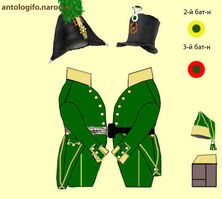| 20th Jäger Regiment 1st Chasseurs Regiment | |
|---|---|
| Active | 1803—1833 |
| Country |
|
| Allegiance | Emperor of Russia |
| Branch |
|
| Role | Skirmishers |
| Size | 3 Battalions |
| Engagements | Polish Revolution |
The 20th Jaeger Regiment (20-й Егерский полк) was a jager regiment of the Imperial Russian Army. Although the regiment was short lived, it did participated in a few well known battles throughout the Napoleonic Wars.
History[]

In 1803, the 20th Jäger Regiment was formed from the companies of the 1st-11th and 13th Jaeger Regiments. Upon formation, the regiment moved to St Petersburg, specifically in the area of Olonets. The regiment was given their skirmisher uniforms with a small difference with green as the regimental colour badges. By 1806, the regiment was assigned to the 5th Infantry Division.
Following the outbreak of the War of the Fourth Coalition, the regiment moved with Michael Andreas Barclay de Tolly's force along with the 2nd and 8th Jager regiments. After this battle the regiment was assigned to the rear-guard and held the enemy for four days before the Battle of Eylau. During the battle, the regiment was garrisoned in the town of Serpalen where they took many attacks which they defended fiercely.
Later that year, the regiment joined Levin August von Bennigsen's army and fought during the Battle of Friedland. During the battle, the regiment was under Major General Nikolay Raevsky's division within the 1st brigade with 3 battalions. During the battle, the regiment was part of the Advance-Guard where they distinguished themselves being charges 2 times by cavalry and holding their position. After these battles, the regiment's banner was embroiled with the St. George Pipes with the inscription "For Dinstinction during the campaigns of 1807 against the French.". The next year in 1808, the Finnish War started and the 1st battalion took part in the Occupation of Gotland. Towards the end of this "expedition" the battalion was forced to surrender.
In 1812, the French invasion of Russia kicked off and the 1st and 3rd Battalions were assigned to the 3rd Infantry Division within the 1st Western Army. The regiment took part in the: Battle of Vitebsk, Battle of Lubin, Battle of Gzhatskoy, Battle of Gridnev, and finally the Battle of Kolotsky. During the Battle of Borodino, the regiment was tasked with the flank defences of General Levin August, Count von Bennigsen's flank where they held off against two major attacked by Marshals Ney and Davout. After these engadements the regiment was moved by the Semyonov ravine.
In October 1812, during the Battle of Tarutino, the regiment charged and, successfully, captured a French artillery battery but were overwhelmed by Carabiniers and Cuirassiers where they had to retreat. The 1st and 3rd battalions later took part in the following battles: Battle of Maloyaroslavets, Battle of Vyazma, Battle of Lyakhov, Battle of Dukhovshchina, Battle of Smolensk, Battle of Krapivna, Battle of Dubrovna, Battle of Borisov, and finally Battle of Oshmyany. The 2nd battalion was assigned to the corps under General Fabian Steinheil where they partook in the following battles: Battle of Ekau, Battle of Santinee, Battle of Altkirchen. For all battalions' service during the invasion, the regiment was given the following on their shakos "For the difference, we march for the Military Difference!".
The regiment continued to serve through the War of the Sixth Coalition in the following: Battle of Lutzen, Battle of Bautzen, Battle of Dresden, Battle of Leipzig, Battle of Bar-sur-Aube, Battle of Lobressel, Battle of Trois-Rivières, Battle of Arcy-sur-Au, and finally the Battle of Paris. By 1815, the regiment was renamed as the 1st Chasseurs Regiment and were granted new banners. In 1831, the 1st and 2nd Battalions took part in the January Revolution in the following: Battle of Vavr, Battle of Grokhov, Battle of Hendrzheev, and finally the Battle of Ostrolenka.

Finally, in 1833 the army was reformed and the following occurred:
- 1st Battalion moved to the Narva Infantry Regiment to form their 3rd, 4th, and 7th Reserve Battalions
- 2nd and 3rd Battalions moved to form the Narva Reserve Infantry Regiment